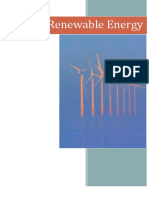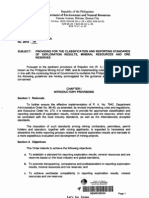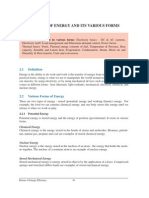Introduction To Energy2
Introduction To Energy2
Uploaded by
Javier RojasCopyright:
Available Formats
Introduction To Energy2
Introduction To Energy2
Uploaded by
Javier RojasOriginal Title
Copyright
Available Formats
Share this document
Did you find this document useful?
Is this content inappropriate?
Copyright:
Available Formats
Introduction To Energy2
Introduction To Energy2
Uploaded by
Javier RojasCopyright:
Available Formats
INTRODUCTION TO
ENERGY SCIENCE
JULY - 2014
Ability to do work or cause
change
Produces Warmth
Produces Light
Produces Sound
Produces Movement
Produces Growth
Powers Technology
What is energy?
Courtesy of NEED
POTENTIAL
KINETIC
Stored energy
or energy of
position
Gravitational, Stored
Mechanical,
Nuclear, Chemical
Energy of
motion
Motion, Electrical,
Sound, Radiant,
Thermal
Classes of Energy
Courtesy of NEED
Gravitational Energy
energy an object or substance
has because of its position
Anything up high
Potential Energy
Stored Mechanical
Energy stored in an object
by the application of force
Must push or pull on an object
Potential Energy
Nuclear Energy
energy stored in the
nucleus of an atom
Holds the atom together
Potential Energy
Chemical Energy
energy stored in the bonds
between atoms
Holds molecules together
Potential Energy
Mechanical (Motion)
Energy movement of
objects or substances from
one place to another
Kinetic Energy
Electrical Energy
movement of electrons
NOT AN ELECTRON
PARADE!
Kinetic Energy
Sound Energy
movement of energy
through substances in
the form of
longitudinal/compressi
on waves
Kinetic Energy
Radiant Energy
electromagnetic energy
that travels in transverse
waves
Kinetic Energy
Kinetic Energy
Thermal (Heat) Energy
internal energy of a
substance due to the
vibration of atoms and
molecules making up the
substance
1 Energy can not be created nor destroyed, only
changed.
Law of Conservation of Energy
First Law of Thermodynamics
2 Energy will always transfer from high to low.
3 No energy transfer is 100% efficient.
Energy Transfers
Conservation
of Energy
Units of Energy
Energy requires a force. Each form of energy
has its own force: gravity, strong & weak
nuclear forces, electrical, and kinetic forces.
Kinetic Force = Mass x Acceleration
Unit of force = 1 Newton = 1 Kilogram x 1 m/s
Energy is a measurement of work accomplished
by a force
Energy = Force x Distance
1 Joule = 1 Newton x 1 Meter
Energy and Power
Energy is a quantity, like distance.
1 kilowatt-hour = 1000 Watts x 1 hour
1 kilowatt-hour = 3.6 x 10
6
Joules
Power is a rate, like speed, it is the rate that
energy is converted from one form to another.
1 Watt = 1 Joule / Second
The Difference Between Energy and Power
Energy
Power
Quantity
Rate
Unit
kWh
kWh
kW, MW*
kW, MW*
Water analogy
Gallons
Gal / Min
Car analogy-
- How far?
- Gallon of gas
Engine HP
Cost example
12 /kWh
12 /kWh
$1,500,000/MW
$1,500,000/MW
Grid
Consumption &
production
Installed
capacity
Laws of Thermodynamics
First Law: In any transformation of energy from
one form to another, the total quantity of energy
remains unchanged. Energy is neither created
nor destroyed, it only changes forms.
Second Law: In all energy changes, the
potential energy of the final state will be less
than that of the initial state (useful energy is
always lost.)
Lost energy is usually energy that has been
converted to heat, but it could be noise (kinetic energy
of air), or other forms of wasted energy.
Efficiency
The ratio of the amount of useable energy
obtained to the amount of energy input is the
efficiency of a process.
This is usually expressed as a percent and it is
always less than 100%.
Energy definitions
Primary Energy amount of energy
contained in the initial source of energy
Delivered Energy amount of useable
energy delivered to the customer
Useful Energy amount of energy attributed
to the amount of work accomplished
What is Electricity?
Electricity is energy transported by
the motion of electrons
**We do not make electricity, we CONVERT other
energy sources into electrical energy**
Conversion is the name of the game
Energy Conversion Options for Electricity
Non-Thermal Paths
Source to Electrical
Source Converter
Sun Photovoltaic (photon to electron)
Chemical Fuel Cell
Source to Potential/Kinetic to Mechanical to Electrical
Source Converter Kinetic to Mechanical Mech to Electrical
Dam Penstocks Turbine (water) Generator
Tides Machine Turbine (air or water) Generator
Wind N/A Turbine (air) Generator
Energy Conversion Options for Electricity
Thermal Paths
Heat to Mechanical to Electrical
Source Heat to Mechanical Mech to Electrical
Geothermal Turbine (vapor) Generator
OTEC Turbine (vapor) Generator
Stored Energy to Heat to Mechanical to Electrical
Source Reactor Heat to Mechanical Mech to Electrical
Fuel Combustor Turbine (gas or vapor) Generator
U, Pu Reactor Turbine (gas or vapor) Generator
Sun Collector* Turbine (gas or vapor) Generator
H, H
2
, H
3
Reactor Turbine (gas or vapor) Generator
* More a modifier or concentrator than a reactor
Faraday Effect
Faraday Effect
Basic Concepts
Voltage V Potential to Move Charge (volts)
Current I Charge Movement (amperes or amps)
Resistance R V = IxR (R in =ohms)
Power P = IxV = I
2
xR (watts)
Electric Motor
M
Electrical
Energy
Mechanical
Energy
DC Motor
Model Electric Motor
Beakman Motor
What do you need?
1. Electric Energy
2. Coil
3. Magnetic Field
Electric Generator
G
Mechanical
Energy
Electrical
Energy
Stationary magnets - rotating magnets - electromagnets
AC/DC
(not the band)
Alternating Current
Large-scale
generators produce
AC
Follows sine wave with
n cycles per second
1, 2, 3-phase?
US:120 V,60 Hz
Europe: 240 V,50Hz
Transforming ability
Direct Current
Batteries, Photovoltaics,
fuel cells, small DC
generators
Charge in ONE direction
Negative, Positive
terminals
Easy conversion AC to
DC, not DC to AC
Generator Phases
1 Phase 2 Phase 3 PhaseSmooth Power
0 0.005 0.01 0.015 0.02 0.025 0.03 0.035
150
100
50
0
50
100
150
200
250
220
110
V t ( )
V
1
t ( )
V
2
t ( )
V
3
t ( )
0.033 0 t
0 0.005 0.01 0.015 0.02 0.025 0.03 0.035
150
100
50
0
50
100
150
110
110
V t ( )
V1 t ( )
V2 t ( )
V3 t ( )
0.033 0 t
0 0.005 0.01 0.015 0.02 0.025 0.03 0.035
150
100
50
0
50
100
150
200
155.563
110
V t ( )
V1 t ( )
V2 t ( )
V3 t ( )
0.033 0 t
Polyphase Systems 3 phases for smoother torque delivery
Force Driving Motor (Red)
Single Phase Two Phase Three Phase
WHERE DO WE GET
ENERGY FROM AND WHAT
DO WE USE IT FOR?
Energy Sources
Non Renewable
Fossil Fuels
Natural Gas
Shale Oil
Tar Sands
Nuclear Fusion Fuel
Renewable
Solar
Geothermal
Tidal
Solar
Direct Sunlight
Wind
Hydroelectric
Ocean Currents
Ocean Thermal Gradients
Biomass
World Primary Energy
Consumption
Energy Consumption Versus
GDP
2010 US Energy Flow
US Energy Consumption
Alaska Energy Consumption
Alaska Energy Consumption
The United States uses more energy per
capita than any other country in the world, and
Alaska as a state has the highest energy per
capita energy use in the narration at 1112
MMBtu per person. This is three times higher
than the national average of 333 MMBtu.
This is due to our cold harsh winters, high
level of air travel
43% of total energy is from jet fuel most of
which is for international flights.
Alaska Energy Consumption
Climate Change Logic
1. The Burning of fossil fuels cause carbon
dioxide concentrations to rise.
2. Carbon dioxide is a greenhouse gas.
3. Increasing the greenhouse effect increases
average global temperatures (among other
impacts)
Does Skeptic mean a person who has not looked at the data?
1000 years of CO2
Concentration
1000 Years of Temperature
Changes
Every Year an Average Coal Plant Releases
3,700,000 tons of CO2
10,000 tons of SO2.
500 tons of particulates
10,200 tons NOx
720 tons of CO
220 tons of volatile organic
compounds (VOC)
170 pounds of mercury
225 pounds of arsenic
114 pounds of lead
And there are over 600 of them in the US.
Source: Union of Concerned Scientists: www.ucsusa.org
Types of Pollutants
CO
2
Global Warming
CO Health problem
PM Respiratory and
heart disease, haze
SOx Acid Rain,
respiratory illness, haze
NOx Ozone formation,
acid rain, smog, nutrient
loading, global warming
Mercury Neurotoxin
Lead Neurotoxin
Arsenic - Poison
VOCs Numerous
health problems
Ozone Health
problems, damage to
flora & fauna
Hundreds of other toxic
chemicals
Power in the Wind
Power = Work / t
= Kinetic Energy / t
= mV
2
/ t
= (Ad)V
2
/t
= AV
2
(d/t)
= AV
3
d/t = V
Power in the Wind = AV
3
A couple things to
remember
Swept Area A = R
2
(m
2
) Area of
the circle swept by the rotor.
= air density in Colorado its
about 1-kg/m
3
Power in the Wind = AV
3
R
Example Calculating Power in the Wind
V = 5 meters (m) per second (s) m/s
= 1.0 kg/m
3
R = .2 m >>>> A = .125 m
2
Power in the Wind = AV
3
= (.5)(1.0)(.125)(5)
3
= 7.85 Watts
Units
= (kg/m
3
)x (m
2
)x (m
3
/s
3
)
= (kg-m)/s
2
x m/s
= N-m/s = Watt
Power in the Wind = AV
3
(kg-m)/s
2
= Newton
Wind Turbine Power
Power from a Wind Turbine Rotor = C
p
AV
3
C
p
is called the power coefficient.
C
p
is the percentage of power in the wind that is
converted into mechanical energy.
What is the maximum amount of energy that can
be extracted from the wind?
Betz Limit when a = 1/3
V
ax
= 2/3V
1
V
2
= V
1
/3
Actuator Disk Model of a Wind
Turbine
Where
Free stream velocity, V
1
Wake velocity, V
2
=(1 2a)
Velocity at rotor, V
ax
= V
1
(1-
a)
Induction factor, a
5926 .
27
16
C
max , p
Rotor Wake
Rotor Disc
Tip Speed Ratio
C
a
p
a
c
i
t
y
F
a
c
t
o
r
Reality Check
Whats the most power the .6 ft turbine in the
example can produce in a 5 m/s wind?
7.85 Watts x .5926 (Betz Limit) = 4.65 Watts
Maximum Possible Power Coefficient
0.60
0.50
0.40
0.30
0.20
0.10
0.00
Cp
10 9 8 7 6 5 4 3 2 1 0
Tip Speed Ratio
Betz - Without Wake Rotation
With Wake Rotation
Tip-Speed Ratio
Tip-speed ratio is the ratio
of the speed of the rotating
blade tip to the speed of
the free stream wind.
R
V
=
R
R
Where,
= rotational speed in radians /sec
R = Rotor Radius
V = Free Stream Velocity
Blade Planform Types
Which should work the best??
Rectangular
Reverse
Linear
Taper
Linear
Taper
Parabolic Taper
Airfoil Nomenclature
wind turbines use the same aerodynamic principals as aircraft
V
R
= Relative Wind
= angle of attack = angle between the chord line and the
direction of the relative wind, V
R
.
V
R
= wind speed seen by the airfoil vector sum of V (free
stream wind) and R (tip speed).
V
R r
V
Airfoil Behavior
The Lift Force is
perpendicular to the
direction of motion. We
want to make this force
BIG.
The Drag Force is
parallel to the direction
of motion. We want to
make this force small.
= low
= medium
<10 degrees
= High
Stall!!
Airfoil in stall (with flow separation)
Stall arises due to separation of flow from airfoil
Stall results in decreasing lift coefficient with
increasing angle of attack
Stall behavior complicated due to blade rotation
Gradual curves
Sharp trailing edge
Round leading edge
Low thickness to chord
ratio
Smooth surfaces
Making Good Airfoils
Good
Not so good
Energy Production Terms
Power in the Wind = 1/2AV
3
Betz Limit - 59% Max
Power Coefficient - C
p
Rated Power Maximum
power generator can
produce.
Capacity factor
Actual energy/maximum
energy
Cut-in wind speed where
energy production begins
Cut-out wind speed where
energy production ends.
Typical Power Curve
Performance Over Range of Tip
Speed Ratios
Power Coefficient Varies with Tip Speed Ratio
Characterized by Cp vs Tip Speed Ratio Curve
0.4
0.3
0.2
0.1
0.0
Cp
12 10 8 6 4 2 0
Tip Speed Ratio
Considerations for Optimum Blade
Optimum blade will have low solidity (10%) and tip speed
ratio, , about 5-7. (match speed to generator)
High means lower pitch angle (blade tip is flat to the
plane of rotation).
Lower means higher pitch angle (feathered).
Pitch angles should be equal for all blades.
Optimum blade has large chord and large twist near hub
and gets thinner near the tip.
Optimum blade is only "optimum" for one tip speed ratio.
The optimum blade will have smooth streamlined airfoils.
Number of Blades One
Rotor must move more
rapidly to capture same
amount of wind
Gearbox ratio reduced
Added weight of
counterbalance negates some
benefits of lighter design
Higher speed means more
noise, visual, and wildlife
impacts
Blades easier to install
because entire rotor can be
assembled on ground
Captures 10% less energy
than two blade design
Ultimately provide no cost
savings
Number of Blades - Two
Advantages &
disadvantages similar
to one blade
Need teetering hub
and or shock
absorbers because of
gyroscopic imbalances
Capture 5% less
energy than three
blade designs
Number of Blades - Three
Balance of
gyroscopic forces
Slower rotation
increases gearbox &
transmission costs
More aesthetic, less
noise, fewer bird
strikes
You might also like
- Stat 255 Supplement 2011 FallDocument78 pagesStat 255 Supplement 2011 Fallgoofbooter100% (1)
- Airflow Quantity MeasurementsDocument16 pagesAirflow Quantity Measurementsadam fakhri100% (1)
- Nonrenewable 6Document13 pagesNonrenewable 6Lalunio Catapang JayveeNo ratings yet
- Mine Survey Slide 1Document16 pagesMine Survey Slide 1Leroy MundaNo ratings yet
- GE 121 Lecture 2 Modes of Mining OperationsDocument34 pagesGE 121 Lecture 2 Modes of Mining OperationsbroddettabatayoNo ratings yet
- Lecture 6Document84 pagesLecture 6Diane G. MonlingNo ratings yet
- Fire Prevention Quiz PSSDocument2 pagesFire Prevention Quiz PSSDeepakKumarNo ratings yet
- Renewable EnergyDocument15 pagesRenewable Energyavenkatesh.2008No ratings yet
- Non-Conventional Source of EnergyDocument36 pagesNon-Conventional Source of EnergyaslamNo ratings yet
- Mining SurveyDocument39 pagesMining SurveyLemma AmanuelNo ratings yet
- GEO1 Week 1for UploadDocument47 pagesGEO1 Week 1for Upload[GM]ARENANo ratings yet
- Mine Surveying CompileDocument31 pagesMine Surveying Compilenuno pereira0% (1)
- DAO 2010-09 - Providing For The Classification and Reporting Standards of Exploration Results, Mineral Resources and Ore ReservesDocument13 pagesDAO 2010-09 - Providing For The Classification and Reporting Standards of Exploration Results, Mineral Resources and Ore ReservesPacific SpectrumNo ratings yet
- Renewable and Non-Renewable Energy Resources and Energy ConservationDocument53 pagesRenewable and Non-Renewable Energy Resources and Energy Conservationwilly irawanNo ratings yet
- Isu Module For Ee 327 Environmental Science and Engineering Bsee 3Document22 pagesIsu Module For Ee 327 Environmental Science and Engineering Bsee 3Army Joel MarianoNo ratings yet
- 1) Economics of Surface MiningDocument10 pages1) Economics of Surface MiningJhon Ace DuricoNo ratings yet
- Rock Mechanics and Tunneling Course Outline: Part One Rock MechanicsDocument39 pagesRock Mechanics and Tunneling Course Outline: Part One Rock MechanicsMulugeta DefaruNo ratings yet
- Mine 422 SyllabusDocument4 pagesMine 422 Syllabusgirmay kasayeNo ratings yet
- Purposes/Objective 4. Equipment Used 5. Procedure Works 6. Result (Booking) 7. Analysis/Data Computation 8. ConclusionDocument9 pagesPurposes/Objective 4. Equipment Used 5. Procedure Works 6. Result (Booking) 7. Analysis/Data Computation 8. ConclusionFarisa ZulkifliNo ratings yet
- A Critical Review of Mine Subsidence Prediction Methods PDFDocument14 pagesA Critical Review of Mine Subsidence Prediction Methods PDFAnonymous KilsV3D100% (3)
- The Legacy of Surface Mining and The 4RDocument7 pagesThe Legacy of Surface Mining and The 4RAlejandro BedoyaNo ratings yet
- Electrochemical Cell: Chapter 2: Electrochemistry Chemistry For Grade 12Document8 pagesElectrochemical Cell: Chapter 2: Electrochemistry Chemistry For Grade 12Farhan Pranadarmesta MerchNo ratings yet
- Energy Resources: in Energy Statitistics It Is Called Primary EnergyDocument34 pagesEnergy Resources: in Energy Statitistics It Is Called Primary EnergyNina AninaNo ratings yet
- Surveying BasicsDocument35 pagesSurveying BasicssrinivasanNo ratings yet
- Modeling of Professional and Scientific Staff ManagementDocument13 pagesModeling of Professional and Scientific Staff Managementst57143No ratings yet
- Fuels and Lubricants PDFDocument20 pagesFuels and Lubricants PDFkamaldeshapriyaNo ratings yet
- Geology Syllabus PDFDocument2 pagesGeology Syllabus PDFChristian GomezNo ratings yet
- Angle of Elevation and DepressionDocument27 pagesAngle of Elevation and DepressionNica BasanalNo ratings yet
- Overview of Safety ManagementDocument24 pagesOverview of Safety ManagementJustine Aldwin SarmientoNo ratings yet
- MINE 170 - Basic Engineering Geology (2021 Session) - TheoryDocument4 pagesMINE 170 - Basic Engineering Geology (2021 Session) - TheorySyed Intizar MehdiNo ratings yet
- Remote Sensing Gis GPS PDFDocument36 pagesRemote Sensing Gis GPS PDFRahul SharmaNo ratings yet
- Mining Report LowDocument202 pagesMining Report Lowpvanheus100% (2)
- B Tech - Mining - III toVIII PDFDocument66 pagesB Tech - Mining - III toVIII PDFajit aryanNo ratings yet
- Location and Control SurveyDocument64 pagesLocation and Control SurveychabarikadanzelNo ratings yet
- 436 33 Powerpoint Slides CHAPTER 1Document69 pages436 33 Powerpoint Slides CHAPTER 1Anonymous PeFQLw19No ratings yet
- Surveying - Chapter 4 (Theodolite)Document123 pagesSurveying - Chapter 4 (Theodolite)Syahirah ZulkifliNo ratings yet
- Introduction of Surveying: Ard - Semester Iv Viva School of Architecture Srushti Jondhale - 05Document6 pagesIntroduction of Surveying: Ard - Semester Iv Viva School of Architecture Srushti Jondhale - 05Sanika MetarNo ratings yet
- Volcanism - GeologyDocument13 pagesVolcanism - GeologyChristian GalopeNo ratings yet
- Philippine Mining Act of 1995.Document31 pagesPhilippine Mining Act of 1995.Neilyn BongalanNo ratings yet
- Mine Closure PDFDocument77 pagesMine Closure PDFЛуис Ангел Кинтеро ГазNo ratings yet
- Auxiliary OperationsDocument2 pagesAuxiliary OperationsLi100% (1)
- Latitude and LongitudeDocument21 pagesLatitude and LongitudeMohammad Asraf Ul Haque100% (1)
- Topohraphy Surveying: Chapter-OneDocument67 pagesTopohraphy Surveying: Chapter-OneTemesgen100% (1)
- Mining Engineers 10-2024Document4 pagesMining Engineers 10-2024PRC BaguioNo ratings yet
- Remote SensingDocument62 pagesRemote SensingwanradhiahNo ratings yet
- 2021 Introduction To Basic Statistics-1 PDFDocument125 pages2021 Introduction To Basic Statistics-1 PDFAbdullah KashmiriNo ratings yet
- Underground SurveyingDocument5 pagesUnderground SurveyingErick AlanNo ratings yet
- SurveyBook 1Document27 pagesSurveyBook 1Vamshee KrishnaNo ratings yet
- Blast Fume Clearance Reentry TimesDocument8 pagesBlast Fume Clearance Reentry TimesYuni_Arifwati_5495No ratings yet
- PlanningDocument5 pagesPlanningArya ShirgaonkarNo ratings yet
- Pressure Variation in Static FluidDocument30 pagesPressure Variation in Static FluidManpreet LittNo ratings yet
- Handout - TRAVERSE SURVEYINGDocument14 pagesHandout - TRAVERSE SURVEYINGCCCCCCCNo ratings yet
- Engineering Economy Lecture1Document33 pagesEngineering Economy Lecture1Jaed CaraigNo ratings yet
- Subdivision of GeologyDocument6 pagesSubdivision of GeologyRenze OreaNo ratings yet
- Engineering Ethics - Concepts and Caces - Cases OnlyDocument52 pagesEngineering Ethics - Concepts and Caces - Cases OnlyChanakun KaewkhamsaenNo ratings yet
- Carbon: Building Block and Fuel SourceDocument4 pagesCarbon: Building Block and Fuel SourceJL V. AdrianoNo ratings yet
- How to Empower Children in the World: Earth Leaders for Environmental MonitoringFrom EverandHow to Empower Children in the World: Earth Leaders for Environmental MonitoringNo ratings yet
- Forms of EnergyDocument18 pagesForms of EnergyJAYESHNo ratings yet
- Ch1 PS (Sec A&b) Fall 2017 LectureDocument20 pagesCh1 PS (Sec A&b) Fall 2017 LecturealiNo ratings yet
- Construct ValidityDocument8 pagesConstruct ValidityPrecious BalgunaNo ratings yet
- Music Theory 1 Study GuideDocument1 pageMusic Theory 1 Study GuideFluteNo ratings yet
- Medium Throw Colinear Source: Electro-AcousticsDocument6 pagesMedium Throw Colinear Source: Electro-AcousticsAnastasios Anax PavlidisNo ratings yet
- Oxygen TutorialDocument6 pagesOxygen TutorialJAVIER FÉLIX MERCHÁN SÁNCHEZ-JARANo ratings yet
- Flashwave 4 1 0 0: Multiservice Provisioning PlatformDocument8 pagesFlashwave 4 1 0 0: Multiservice Provisioning PlatformAugtron Anders100% (1)
- 2uz Secnary Air MalDocument12 pages2uz Secnary Air MalJansen BlancoNo ratings yet
- Pds-Purac FCC 88 (0306)Document1 pagePds-Purac FCC 88 (0306)Hadi SutrisnoNo ratings yet
- Statistics For Engineers (MAT2001) - SyllabusDocument3 pagesStatistics For Engineers (MAT2001) - Syllabusmanjeet kumarNo ratings yet
- Pd-Catalyzed Formal Mizoroki - Heck Coupling of Unactivated Alkyl ChloridesDocument12 pagesPd-Catalyzed Formal Mizoroki - Heck Coupling of Unactivated Alkyl ChloridesardiNo ratings yet
- Al Shaer2016Document36 pagesAl Shaer2016rosa kristianingrumNo ratings yet
- WinCC TIA Portal Soap DOC enDocument10 pagesWinCC TIA Portal Soap DOC eny kartheekNo ratings yet
- Cable Selection Guide For Process InstrumentationDocument3 pagesCable Selection Guide For Process InstrumentationyoungfpNo ratings yet
- Ec2255 - Control SystemDocument42 pagesEc2255 - Control Systemselvi0412No ratings yet
- Fund Performance Comparison Feb 2022Document5 pagesFund Performance Comparison Feb 2022Fariz YusofNo ratings yet
- I. Learning ObjectiveDocument4 pagesI. Learning Objectivenorhanifah matanogNo ratings yet
- Skype+Developer+ +Skype+Desktop+API+Reference+ManualDocument129 pagesSkype+Developer+ +Skype+Desktop+API+Reference+ManualJonathan CortesNo ratings yet
- Digital 1000 Ampere AC Clamp Meter HIOKI 3282Document2 pagesDigital 1000 Ampere AC Clamp Meter HIOKI 3282industrialindiaNo ratings yet
- Course HV-5010Document51 pagesCourse HV-5010forevertay2000No ratings yet
- 11 Lecture PDFDocument14 pages11 Lecture PDFAE07No ratings yet
- FLUID MECHANICS Multiple Choice QuestionsDocument8 pagesFLUID MECHANICS Multiple Choice QuestionsleGion0% (1)
- Fisk, Eliot - Interpreter's Notes Etude 1 (Frets Sep 81)Document1 pageFisk, Eliot - Interpreter's Notes Etude 1 (Frets Sep 81)Yip Alex50% (2)
- Handplane Tune UpDocument6 pagesHandplane Tune UpAndrew Catlin100% (5)
- Enous Hromboembolism Report Form:: HospitalDocument4 pagesEnous Hromboembolism Report Form:: HospitalHosam GomaaNo ratings yet
- LR 1702021903 Tesla ReprintDocument4 pagesLR 1702021903 Tesla ReprintDinca SimunicNo ratings yet
- 033 - Flight Planning Monitoring - AnswersDocument109 pages033 - Flight Planning Monitoring - AnswersEASA ATPL Question Bank0% (1)
- LG 43LH570 Chassis LD66HDocument57 pagesLG 43LH570 Chassis LD66HAlonso LamusNo ratings yet
- Reasoning Shortcut TricksDocument53 pagesReasoning Shortcut TricksDave PachecaNo ratings yet
- Iit-Jee W MarkDocument20 pagesIit-Jee W MarkVikas KumarNo ratings yet
- Incompressible Navier-Stokes RequirementsDocument13 pagesIncompressible Navier-Stokes Requirementsramy86No ratings yet
- AI Assignment 3Document5 pagesAI Assignment 3Tigabu YayaNo ratings yet

























































































